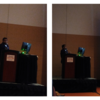
The Weitz Lab is proud to announce that group member Arka recently gave a talk at the CellBio’23, the annual meeting of renowned ASCB (American Society for Cell Biology) in December 2023 in Boston, where he presented his innovative research. The annual event brings together physicists, biologists and researchers to discuss the latest developments in cell biology. Also in attendance at the meeting was Tommy, Thomas, Sijie and Max from the group.
Here are the details of the presentation. Congratulations on their successful participation in the Meeting!
SG181 - Vimentin Filament Precursor Droplets and Stress Fiber Stabilization
Author Block: A. Basu, T. Krug, D. A. Weitz; Harvard John A. Paulson School of Engineering and Applied Sciences, Harvard University, Cambridge, MA.
Liquid-liquid phase separation (LLPS) is increasingly being recognized as a key player in cytoskeletal organization ranging from Nephrin clusters in actin nucleation1 to centrosomes in the case of microtubes2. Though relatively little is known for the intermediate filaments3,4, it has been shown that Vimentin forms precursor puncta before maturing into Vimentin Intermediate Filaments (VIFs) and VIFs reversibly dissolve into puncta during cell division and attachment. In this work, we employed a cell line with mutated Vimentin that prevents formation of VIFs to explore the physical properties of precursor puncta and their interaction with other cellular elements. These precursors were revealed to be LLPS condensates by their selective and reversible dissolution upon 1,6-Hexanediol treatment. They also dissolved upon application of osmotic stress while actin fibers were relatively undisturbed. In vivo shape fluctuations of these droplets were used to estimate their surface tension and their merging and splitting behavior was used to estimate their viscosity; both surface tension and viscosity values were consistent with other biological condensates. We observed extensive colocalization of the Vimentin droplets with actin stress fibers resulting in oscillatory motion of colocalized droplets compared to the random motion of the free ones. Similar colocalization was also observed at low concentration of Vimentin in cells which eventually formed complete VIFs upon increasing concentration. This co-localization is reminiscent of the physical phenomenon of liquid droplets wetting a filament; wetting of stress fibers were further confirmed by elongation of droplets along the fibers and inefficient recognition droplet coated stress fibers by F-actin specific dyes. Wetting of stress fibers with Vimentin droplets affected actin treadmilling as evidenced by the stabilization of stress fibers against Cytochalasin B and Latrunculin A treatment. The liquid-like nature of droplets and their tendency to wet stress fibers can be immensely important in understanding the growth of VIFs from droplet precursors using the stress fibers as a template.
1.Case, L. B., Zhang, X., Ditlev, J. A. & Rosen, M. K. Stoichiometry controls activity of phase-separated clusters of actin signaling proteins. Science 363, 1093-1097 (2019)2.Raff, J. W. Phase Separation and the Centrosome: A Fait Accompli? Trends Cell Biol 29, 612-622 (2019)3.Wu, H. et al. Vimentin intermediate filaments and filamentous actin form unexpected interpenetrating networks that redefine the cell cortex. Proceedings of the National Academy of Sciences 119, (2022)4.Zhou, X. et al. Transiently structured head domains control intermediate filament assembly. Proceedings of the National Academy of Sciences 118, (2021)




